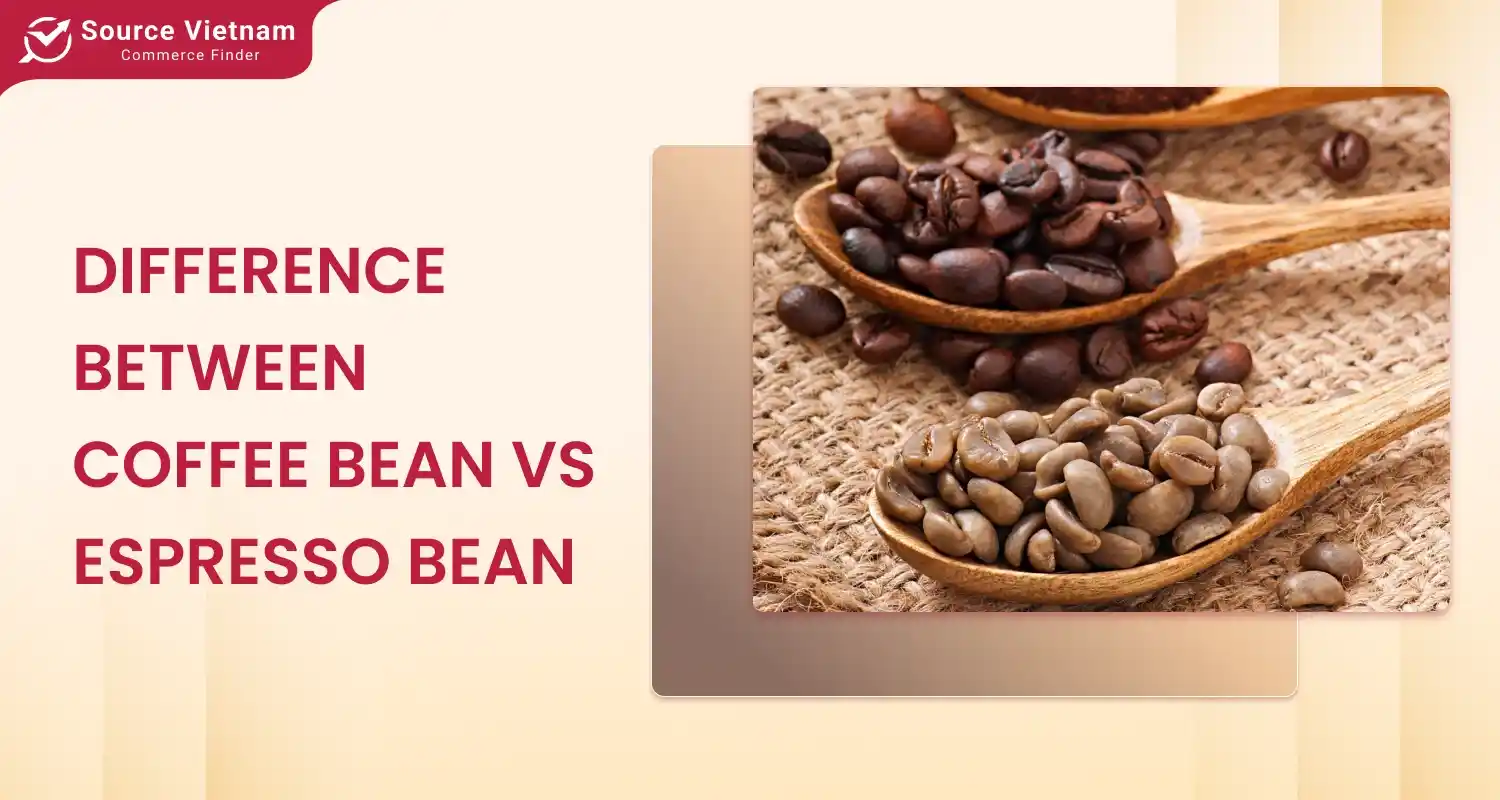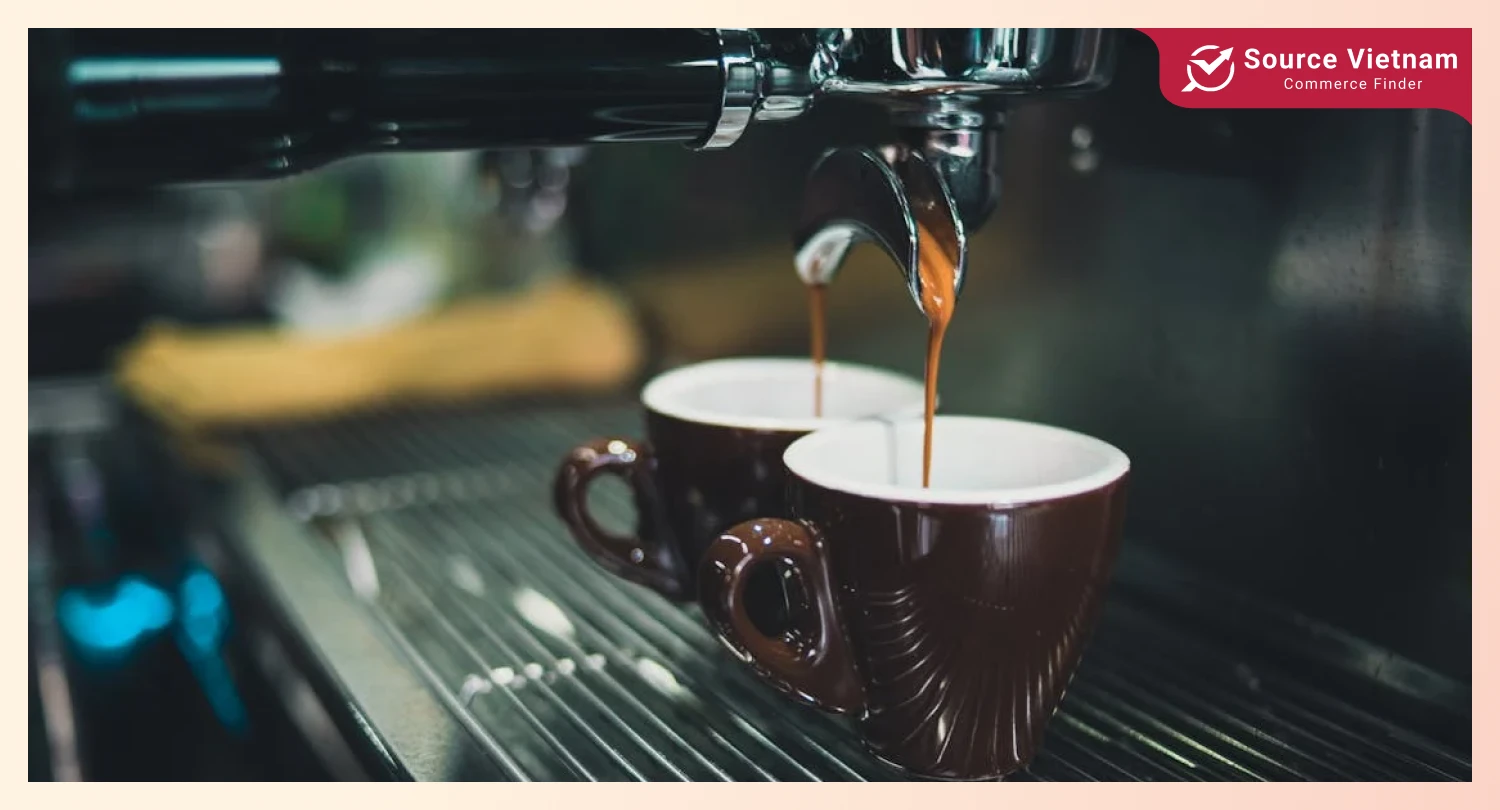Insight:
- There are two main misconceptions about coffee beans: espresso beans are a distinct type of bean, and espresso has more caffeine.
- In reality, espresso beans are just regular coffee beans that are roasted darker and ground finer for espresso machines.
- The brewing method and roast level are what make the difference in taste and caffeine content.

You may ask why you bother learning about the difference between coffee bean and espresso bean. These insights can unlock great coffee tastes and flavors. This blog will help you differentiate espresso from regular beans by analyzing the blend ratios, roast levels, grind size, and brewing methods. Let’s take a sip and unlock the secrets of coffee bean varieties!
What are coffee beans?

Coffee beans are the ingredients for the most popular drink in the world. But before becoming the ones you see in the package, they are the seeds of the coffee plant, also known as coffee cherries.
After being harvested, people will remove their gulps and dry them. The coffee beans we see are through the process of roasting to enhance their flavor and aroma. There are multiple coffee bean types, yet Arabica and Robusta are two common beans.
What are espresso beans?

A common misconception is that espresso beans are distinct coffee beans, while espresso is a blend between different coffee bean types. The blending between Arabica and Robusta is the most popular for espresso.
Is your coffee bean choice affecting your brew? Certain varieties with different ratios, brewing techniques, and roast levels can generate different tastes, which we will discuss further in the following sections.
Read more >>> TOP 10 Best Wholesale Coffee Bean Suppliers for Your Business
What’s the difference between coffee bean and espresso bean?
Understanding the differences between coffee beans and espresso beans is crucial for those who want to pursue a professional coffee-making path or make the perfect cup of coffee to their tastes. This section illuminates coffee bean differences in bean types, roast level, grind size, brewing method, flavor profile, and caffeine level.
| Difference Points | Coffee Bean | Espresso Bean |
| Bean type | Common types are Arabica and Robusta | Blending of Robusta, Arabica, and crema with different ratios. |
| Roast level | Light roasting
Medium roasting Dark roasting |
Dark roasting |
| Grind size | Coarse size
Medium size Fine size |
Fine size |
| Brewing method | Dripping
Pour-over Cold brew |
High-pressure brewing |
| Flavor profile | Arabica beans: Fruity, floral, and chocolate
Robusta beans: Earthy and bitter |
Nutty, chocolatey, bitter, and sometimes sour profiles |
| Caffeine content | Robusta has more caffeine content than arabica | Depending on the ratio of blending between bean types. |
Bean type

The diversity of coffee bean types is for no debate, yet there are two primary types, Arabica and Robusta. Each bean has different characteristics, flavor, caffeine content, and aroma.
For instance, Arabica is common for filter coffee, pour-overs, and specialty coffee drinks as it has complex and nuanced flavors of fruity, floral, or chocolatey. On the other hand, Robusta is famous for its strong and bold flavor of being earthy and slightly bitter notes with high caffeine content.
Espresso beans blend coffee beans with crema to generate unique tastes and feel. Some common blending types of espresso beans include arabica-dominant blends, robusta-dominant blends, or balanced blends between arabica and robusta beans.
Read more >> History of Coffee in Vietnam: From Colony to Global Icon
Roast level

The roasting methods for coffee and espresso beans are not much different. People still apply common approaches such as drum roasting, fluid bed roasting, air roasting, etc. Yet, the roast level is the difference in categorizing beans. Coffee beans might have a light roast with high acidity and floral notes or a medium roast with balanced acidity, sweetness, and bitterness.
Meanwhile, espresso beans typically have a dark roast to reduce acidity and intensify the bold, intense flavors. Besides, one of the key factors for espresso bean roasting is even roasting to avoid uneven extraction and bitter flavors. Rapid cooling after roasting also plays an important role in preserving the signature espresso bean flavor and aroma.
Grind size
Grind size is another factor that sets espresso beans apart from coffee beans. Espresso beans often have fine grind, crucial for high-pressure extraction to create resistance. Hence, the beans can extract maximum flavor and oils in hot water while making espresso coffee.
Coffee beans do not have a specific grind size, as they depend on the brewing method and desired effects. For example, coarse grind favors longer brewing time and fuller flavor extraction. Medium grind, on the other hand, is more suitable for drip coffee makers as it balances extraction time and flavor intensity.
Brewing Method

As mentioned earlier, the specific grind size of espresso is a cut-out for high-pressure brewing approaches. You can use either an espresso machine or a moka pot to suppress hot water on espresso beans, to extract a much stronger and more concentrated beverage.
Coffee beans do not frame themselves in a brewing method. You can drip hot water over coffee grounds or steep them in hot water, then use a plunger for filtering. Other methods to regular beans also apply, including pour-over and cold brew.
Flavor profile
The flavor profiles of coffee and espresso beans will consequently stand out from each other due to different grind sizes, roasting, and brewing methods. Espresso beans with dark roasting, fine grind size, and high-pressure brewing can have nutty, chocolatey, bitter, and sometimes sour profiles.
Read more >>>> How to Make Whole Bean Coffee Without a Grinder
It might be challenging to point out the signature profile of regular coffee beans, compared with the espresso bean characteristics. Each grind size, brewing, and roasting approach can have a different flavor profile. For instance, the flavor of arabica beans tends to be fruity, floral, and chocolate. The robusta beans might go for being earthy and bitter.
Caffeine content
Due to the dark roast level and blended beans of Arabica and Robusta, espresso beans tend to have a more intense flavor. The coffee bean roasting process does not impact increasing or decreasing caffeine content, but the bean type does.
So, espresso does not necessarily contain more caffeine per bean than regular coffee. Meanwhile, robusta beans generally transcend the caffeine content of Arabica beans.
After a brief walkthrough above, you might have more insights into the main difference between coffee bean and espresso bean. So, is your coffee bean choice affecting your brew? You will find an answer in the next section.
Choosing the right beans for your brew

The best way to find out how to choose between coffee and espresso beans is to identify your desired tastes. The change of brewing methods with different beans can alter the way a cup of coffee you want to perceive.
As mentioned earlier, different roast levels and blend ratios between Arabica and Robusta can generate unique tastes. Espresso might be best when you have darker roasts, and blend Arabica with Robusta for crema and body. You might need more precise brewing techniques to extract their full potential if you use only one original bean from a specific region or farm for espresso.
Pour-over, on the other hand, can have its optimal flavor and taste when having light to medium roasts. You can also enjoy a full-bodied, flavorful brew for a French press when using medium to dark roasts. Another appealing choice is a balanced cup of Coffeedrip Coffee in medium roasts.
These understandings of the difference between coffee bean and espresso bean can alleviate how to find out which beans are perfect for your brewing method.
Popular brands offering coffee and espresso beans
Coffee is the favorite drink of many people around the work, yet only those who know the best how-tos can make a cup of coffee your preferences. Why don’t we discover the top coffee bean brands for every taste?

Specialty coffee roasters:
- Stumptown: has a reputation as among the best specialty coffee roasters because of its comprehensive process of producing, sourcing, roasting, and tasting. It has a great farming network and excellent relationships with producers for direct trade. Hence, the brand can monitor and control quality from the beginning to the end.
- Intelligentsia: is a roaster brand from Chicago, best known for its innovative approach to coffee, so coffee beans from unique origins. So, it can offer a diverse selection of single-origin and blended coffees, including espresso.
- Counter culture: has nearly 30 years of experience sourcing and roasting coffee beans to deliver the best quality with diverse choices. The brand is famous for its commitment to sustainability. Hence, it focuses on sourcing and producing environmentally friendly coffee, minimizing waste, and boosting longer-term solutions to environmental challenges.

Large coffee brands:
- Lavazza: is not a strange name for those who adore Italian espresso. You can drink almost every espresso coffee you want and even discover outstanding blending to freshen your journeys with espresso.
- Starbucks: needs no introduction as it has expanded its reach worldwide with many stores in many big cities. People love Starbucks for its various categories of coffee beans and styles, such as espresso and drip coffee.
- Peet’s coffee: will create a deep impression on coffee drinkers because of its bold, flavorful coffee. ThCoffeed tries different beans for diverse brewing methods. Hence, it can deliver unique flavors that speak for the drinkers’ personality.
Conclusion
Insights into the difference between coffee beans and espresso beans can help you adjust the blend ratios between Arabica and Robusta to have the desired taste and flavor. Besides, roast level, brewing, and grind size are important factors that impact your cup of coffee. HoCoffeey, the information above guides you through some aspects and gets you to your preferences for coffee.
If Coffee is a coffee shop owner looking for a wholesale coffee manufacturer or distributor, we highly recommend checking out SourceVietnam.com, an online wholesale platform where you can find almost everything.
FAQs
Can I use espresso beans for drip coffee?
Yes, you can. Using drip for espresso beans can leverage their dark roasting to produce a strong and rich cup. Ideal espresso beans for drip coffee are medium-coarse grind at a low water temperature to reduce over-extraction and bitterness. Another influential factor in the taste of your coffee is coffee time. The longer the brewing process, the stronger and more intense the flavor.
What are the best coffee beans for a French press?
It can be challenging when choosing the best beans for espresso vs. regular coffee for the coffee press, as it involves multiple factors. Here are some viable suggestions for optimal flavor extraction.
A French press might work well with medium to dark roasts with a coarse grind, as this combination can save you from experiencing a bitter taste while enhancing coffee flavor.
A dark roast is for a bolder, more intense flavor, while a medium roast might be a better alternative for a nuanced, complex flavor. You can also consider the ratio of blended coffee betCoffeerabica and Robusta beans to match your preferences.
Do espresso beans have more caffeine?
Not necessarily, as the beans might not have more caffeine than regular beans, yet the blend and brewing method ratio can lead to a more concentrated caffeine dose. For instance, if the espresso is a robusta-dominant blend combined brewing with an espresso machine, it can contain more caffeine than a cup of drip coffee.
How can I tell if a coffee bean is suitable for espresso?
You should consider some important aspects of a coffee bean, such as its variety, roast level, and grind size. Espresso coffee is typically a mixture of finely ground Arabica and Robusta with different ratios based on your preferences for coffee flavor profiles. People often use dark roasts for espresso to generate a fuller body, lower acidity, and a more intense flavor profile than light roasts.















